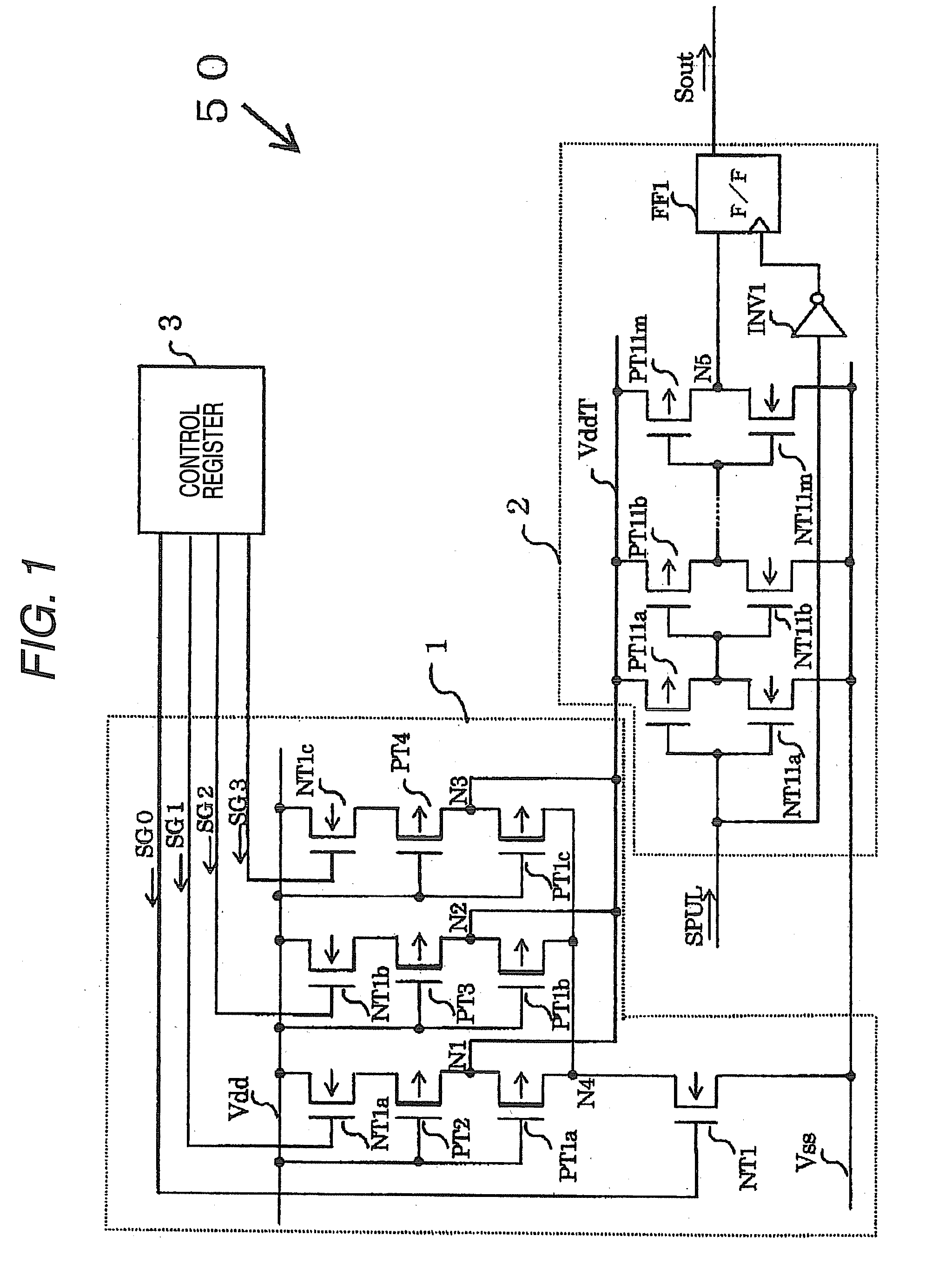Semiconductor integrated circuit
a technology of integrated circuits and semiconductors, applied in the field of temperature detection, can solve the problems of increasing the mounting area of temperature sensors, increasing the number of measurement points, and increasing the cost of them
- Summary
- Abstract
- Description
- Claims
- Application Information
AI Technical Summary
Benefits of technology
Problems solved by technology
Method used
Image
Examples
embodiment 1
[0020]First, a temperature detection circuit according to Embodiment 1 of the invention is described with reference to the accompanying drawings. FIG. 1 is a circuit diagram illustrating the temperature detection circuit according to Embodiment 1 of the invention. FIG. 2 is a graph illustrating the temperature dependence of the off-resistance of a D-type P-channel metal oxide semiconductor (MOS) transistor constituting a voltage generating circuit portion according to Embodiment 1 of the invention. FIG. 3 is a diagram illustrating an operation of the voltage generating circuit portion according to Embodiment 1 of the invention. FIG. 4 is a graph illustrating the temperature dependence of a dropped high-potential-side power supply voltage output from the voltage generating circuit portion according to Embodiment 1 of the invention. In the present embodiment, a temperature is detected using a dropped high-potential power supply voltage having temperature dependence, and an inverter ch...
embodiment 2
[0057]Next, a temperature detection circuit according to Embodiment 2 of the invention is described below with reference to the accompanying drawings. FIG. 7 is a circuit diagram illustrating the voltage generating circuit portion according to Embodiment 2 of the invention. FIG. 8 is a diagram illustrating an operation of the voltage generating circuit portion according to Embodiment 2 of the invention The voltage generating circuit portion according to the present embodiment generates a dropped high-potential-side power supply voltage, which has temperature dependence, using the on-resistance of an N-channel MIS transistor.
[0058]Hereinafter, components of the present embodiment, which are the same as associated-components of Embodiment 1, are designated by the same reference numerals as reference numerals designating the associated-components used in Embodiment 1. Thus, the description of such components of Embodiment 2 is omitted. In the following description, only the differences...
embodiment 3
[0077]Next, a temperature detection circuit according to Embodiment 3 of the invention is described below with reference to the accompanying drawings. FIG. 9 is a circuit diagram illustrating a temperature detection circuit according to Embodiment 3 of the invention. FIG. 10 is a graph illustrating the temperature dependence of resistances constituting a voltage generating circuit portion according to Embodiment 3 of the invention. FIG. 11 is a graph illustrating a temperature detected by the temperature detection circuit according to Embodiment 3 of the invention. The voltage generating circuit portion according to the present embodiment generates a dropped high-potential-side power supply voltage, which has temperature dependence, using resistors.
[0078]Hereinafter, components of the present embodiment, which are the same as associated-components of Embodiment 1, are designated by the same reference numerals as reference numerals designating the associated-components used in Embodi...
PUM
| Property | Measurement | Unit |
|---|---|---|
| temperature | aaaaa | aaaaa |
| voltage | aaaaa | aaaaa |
| temperature coefficient | aaaaa | aaaaa |
Abstract
Description
Claims
Application Information
 Login to View More
Login to View More - R&D
- Intellectual Property
- Life Sciences
- Materials
- Tech Scout
- Unparalleled Data Quality
- Higher Quality Content
- 60% Fewer Hallucinations
Browse by: Latest US Patents, China's latest patents, Technical Efficacy Thesaurus, Application Domain, Technology Topic, Popular Technical Reports.
© 2025 PatSnap. All rights reserved.Legal|Privacy policy|Modern Slavery Act Transparency Statement|Sitemap|About US| Contact US: help@patsnap.com



